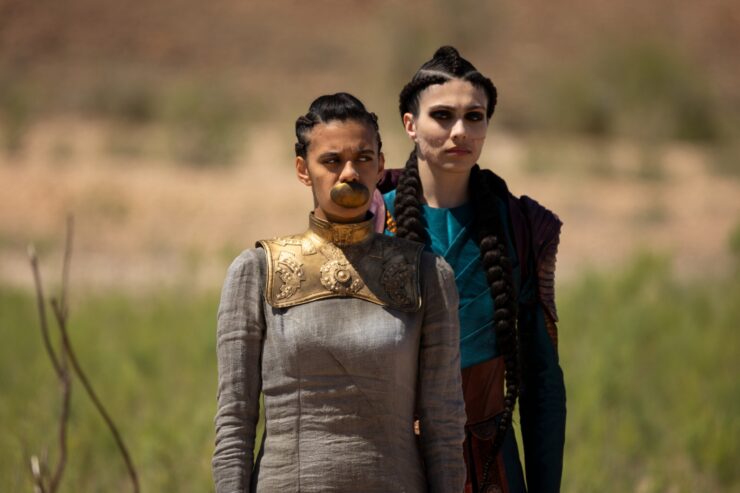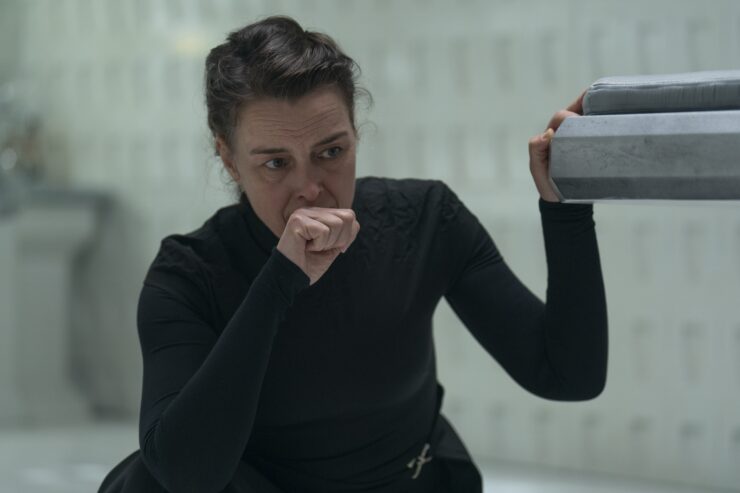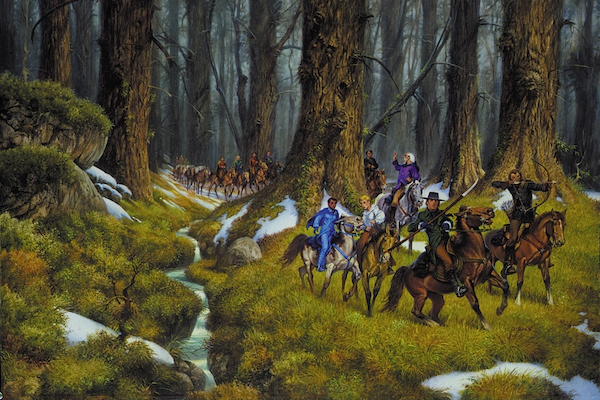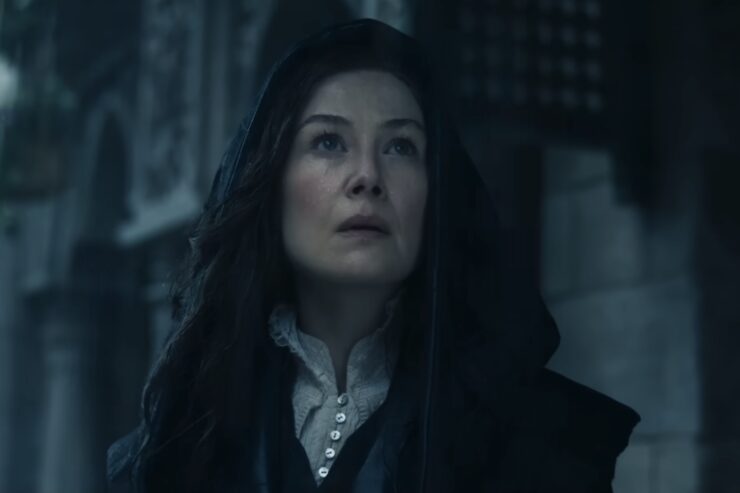“The Power inside you is the smallest part of your strength. It’s your mind, and how you use it, that will mean much more in the battles to come.”
—Moiraine to Egwene, S1E2, “Shadow’s Waiting”
In the finale of season two of The Wheel of Time, Egwene finally gets her opportunity to defy Renna and gain the upper hand. By refusing to fight for the Seanchan, she creates an opening that allows the Whitecloaks to take out the ranks of the sul’dam and damane. Only Renna and Egwene manage to survive, and Egwene is able to obtain an a’dam and put it on Renna. With each woman wearing the bracelet to the other’s collar, a battle of wills ensues as Egwene explains that Renna, too, is capable of channeling. Renna releases Egwene in the hope of being released in turn, but Egwene carries through on her earlier promise to kill her captor, and strangles Renna to death.
After two and a half episodes of watching Egwene being emotionally and physically brutalized, it was very satisfying to see Egwene get her revenge, especially because this is a revenge she doesn’t get in the books upon which the show is based. But something about the scene didn’t sit right for me, and that problem is also a result of changes the show has made from the source material.
[This essay contains minor spoilers for world-building aspects of the Wheel of Time novels, and spoilers for season two of the television show.]
Whenever I analyze the television series The Wheel of Time, I always feel like I have to reiterate one very important point: The greatest challenge to adapting Robert Jordan’s work is the absolute density of the source material. From the world building, to the plot, to the number of important secondary and even tertiary characters, this fifteen book series averages out to over 800 pages per novel, and is particularly loved for its complexity. Even if the show had more than an (in my opinion) measly eight episodes per season, the writers would still be constrained to streamline many of the world-building and plot elements, and to cut quite a few others in their entirety. The show has struggled somewhat to hit the right balance, especially in season two, but there are also a lot of elements that I have really enjoyed. One of these is how the One Power works.
The show hasn’t changed what the One Power is and what it can do, but slight shifts in nuance have allowed the show to bypass some of the more problematic aspects of the world building, and to streamline a very complicated system into something that is true to the heart of the story but not unnecessarily bogged down in facts that it doesn’t have time to adequately explore.
The way the show decided to present the One Power was especially important to me in season one, because the writers made a point of de-emphasizing the difference between the male and female halves of the One Power, which reduced some of the sexism inherent in Jordan’s very binary-driven magic system. In season two, however, the subtle changes the show made around how the ability to channel manifests itself ended up slightly altering the revelation that the sul’dam also posess this ability.
Buy the Book
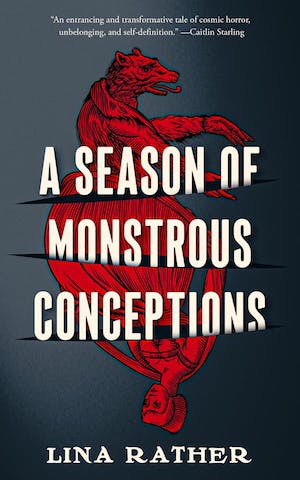

A Season of Monstrous Conceptions
In the novels of The Wheel of Time, there are two ways of becoming a channeler. One way is to be born with what the Aes Sedai call “the spark.” People born with the spark will at some point instinctively channel the One Power, even if they aren’t aware that they have the ability, and even if they don’t receive any training. However, not every channeler is born with the spark; in these cases, their potential has to be uncovered through testing by an Aes Sedai, or by an equivalently experienced channeler.
There is a lot of interesting and complicated world building around different ways people become channelers. The spark is particularly relevant because there are many dangers around touching the True Source—the well from which the One Power springs—without guidance. For example, drawing too much of the One Power can be deadly, and a channeler also risks burning themselves out—destroying the part of themselves that allows them to channel and rendering themselves unable to touch the True Source ever again. If someone born with the spark isn’t given proper training, they will either die or find a rough sort of control over their abilities, often by developing a block that stops or severely limits their ability to channel, and often without ever realizing what they have done. The Aes Sedai call these women wilders.
Nynaeve is one example of a wilder. She and Egwene were both born with the spark, although Egwene hadn’t yet touched the Source before she met Moiraine. Nynaeve first channeled some years before Moiraine came to the Two Rivers, instinctively using the One Power to help heal sick villagers and to predict the weather. But she doesn’t realize what she is doing until Moiraine teaches her, and for a long time experiences a block against channeling that she can’t overcome unless she is angry.
Women who have been trained to channel can also see—in a metaphysical sense—when another woman is holding the One Power, and they can see whatever weaves she constructs. They can also sense the ability to channel in any woman who is close to manifesting her spark, but other potential channelers can’t be detected without further testing. For example, Moiraine is immediately aware of Egwene’s potential and of the fact that Nynaeve has already begun to channel on her own.
While the show doesn’t seem to have a concept of those born with the spark and those without, it still keeps most of the trappings of the experience. In the second episode, Moiraine tells Egwene that touching the Source will come to her, whether she wants it to or not. She then leads Egwene through a meditative exercise, focusing on the blue stone of Moriaine’s hairpiece and imagining she is being carried by a river. Egwene is then able to channel for a brief moment, though she is unsure if she really did so until Moiraine confirms it.
In this scene, we learn that Egwene will instinctively channel at some point, regardless of Moiraine’s interference, and we also see how an Aes Sedai might test a girl’s ability, through the joint channeling around the stone. Moiraine even acknowledges the Wisdom skill of listening to the wind as being linked to channeling with the line; “You don’t listen to the wind, Egwene. It’s the wind that listens to you.” The viewer believes Nynaeve is dead at this point, but when she turns out to have survived being taken by the Trolloc, we can also guess that she, too, must be a future channeler.
Although the more intricate details of the One Power are very interesting, they aren’t strictly necessary for the story, and I think the show has given us all we need to understand the plot arc and the emotional underpinnings of what channeling means. The concept of a “block” hasn’t been brought up by any of the Aes Sedai, but we can see Nynaeve’s struggle with channeling, can understand her fear and distrust of the One Power, without that exact concept being present. Even if this phenomenon of channeling is never outlined and defined for us as such, it doesn’t change what it means for Nynaeve to go through such a struggle.
And then there’s Egwene, the Seanchan, and the a’dam.
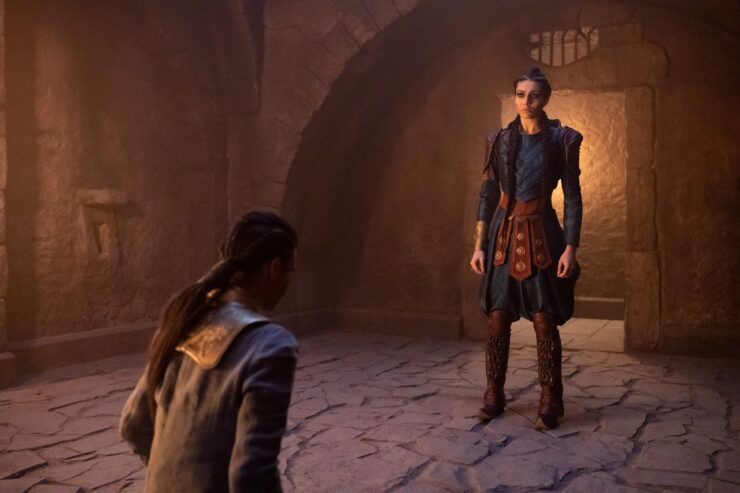
In the season two finale, Egwene realizes that the a’dam is a device that creates a link between the woman wearing the collar and the woman wearing the bracelet. Like the audience, Egwene is still learning the basics of how the One Power works and what a woman can do with it, but she has learned enough to figure out this much about the a’dam. As has the viewer. The show has given us some examples of how linking works, such as when Moiraine and Alanna linked with Liandrin to stop Logain from escaping, and when Nynaeve and Egwene, along with a few others, were linked with Lady Amalisa during the fight at Fal Dara. In both cases we saw that only one person is in charge of channeling when women are linked—Liandrin in the first case, and Amalisa in the second—while the other or others become a vessel through which the leader draws the One Power. At Fal Dara we also saw that it is possible for the person in charge to force the other(s) to channel more of the One Power than they can actually handle, even to the point of killing them.
The clues about Renna and the truth about the sul’dam were there for us to figure out, as Egwene did. Of course, as a book fan, I already knew about the reveal that Renna and her cohorts were also (potential) channelers. But in the books the distinction between those women who are marked out as damane and those who become sul’dam is based on whether or not they are born with the spark. Just as Aes Sedai can recognize the ability in “sparkers” who are either close to touching, or have recently touched, the True Source, so can the damane, and any sul’dam linked to a damane. And just as Aes Sedai must test for those who have the potential to learn but will not channel without teaching, so must the Seanchan.
In chapter 38 of The Shadow Rising, the fourth book in the series, a Seanchan sea captain named Egeanin has recently learned that at least some of the sul’dam can be affected by the a’dam just as a damane would be. Egeanin is shocked at the discovery, and reflects on the process by which damane and sul’dam are discovered.
The yearly testings all across Seanchan found every girl who had the spark of channeling in her: each was struck from the rolls of citizens, struck from family records, taken away to become collared damane. The same testings found the girls who could learn to wear the bracelet of the sul’dam. No woman escaped being tested each year until she was old enough that she would have begun channeling if the spark was there. How could even one girl be taken for sul’dam when she was damane? Yet there Bethamin was in the basement, held by an a’dam as by an anchor.
Because channelers are enslaved by the Seanchan and used mostly for war, both the ordinary citizens and the channelers know very little about how the One Power actually works. They do not realize that there is any other way to become a channeler other than to manifest it instinctually, to have “the spark of channeling” in them. Not knowing how the a’dam works or what linking is means that they have no clues to understand why only certain women are able to become sul’dam and learn to control the a’dam—and because they despise the One Power, they don’t care enough to wonder about it.
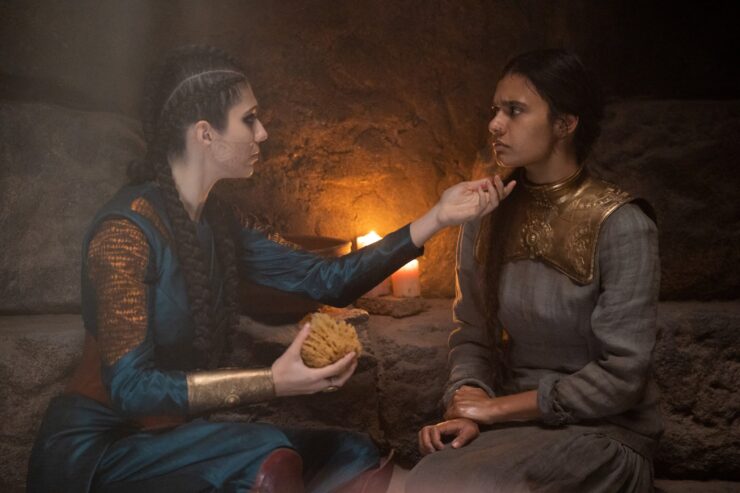
An aside: One assumes that this fact about the sul’dam must have been known at the time the a’dam was invented. Perhaps during the early years of enslaving channelers, the Seanchan drew a distinction between those who would touch the True Source regardless of their intention and those who wouldn’t unless taught. Over time, the knowledge of the sul’dam’s potential was forgotten, perhaps even deliberately, and such a distinction was no longer needed. We can also conclude that directing a link is a form of channeling: The a’dam does the work for the sul’dam so she doesn’t learn how to do anything on her own, but she has opened up the ability in herself, which is why the collars will then work on any woman who has been a sul’dam.
The difference between having been born with the spark or discovered as a potential learner is, in many ways, one of semantics. Though sparkers tend to be very powerful once trained, there are plenty of strong Aes Sedai in both groups, and they channel the same way. The spark really only matters for an Aes Sedai in how her journey begins. But for the Seanchan, the differences are more important; a woman with the spark will end up enslaved and treated as sub-human, while a woman who can learn gains a decently important position in society… at least as long as she and everyone else remain ignorant of the truth.
But the show has not made this distinction between sparkers and those who can be taught. Instead, it tells us that the difference is one of degrees. Just as Ryma explained to Elayne and Nynaeve that small amounts of channeling are hard to detect but using large amounts of the One Power will result in being sensed by the damane, it turns out to be the same for those who are very weak in the One Power. Damane are those who are powerful enough to be detected by other channelers, while the sul’dam are those who are so weak they slip through the cracks. One assumes that in the show version of the world, the Seanchan rely on the damane to detect all the potential damane, and then the sul’dam are found by trying on the bracelet to see if they are able to use it. Indeed, this may also be the way it is done in the books; to the best of my knowledge we are never given exact specifics of how testing is done.
Egwene’s confrontation with Renna is a powerful moment. In the books she never has this opportunity, as she is rescued by Nynaeve, Elayne, and Min instead. I heartily approve of this change. Not only is it more thematically powerful—especially after we witnessed Renna’s casual dehumanization of the enslaved women and her belief that Egwene owed her not only obedience but loyalty and love—it also shows us Egwene’s inner strength. In the books, Egwene is revealed to be exceptionally strong-willed and determined; she is also quite ruthless when she believes she has to be. But much of her journey is an internal one, and between that and the need to streamline her story to fit into the limited space the show has for it, this part of the character could easily have been lost in translation.
There is something incredibly thematically satisfying about how Renna spent all this time trying to break Egwene, but despite having had all the power for most of their relationship, the moment the two were on an equal playing field there was no question as to whose will was stronger. Egwene must have been physically exhausted, undernourished, dehydrated, and aching from all she endured, and because Renna was still wearing the bracelet to Egwene’s collar, she would have felt twice what Renna was feeling as she suffocated. But I never doubted for a second that Egwene was willing to die and take Renna with her if that’s what she had to do. I never doubted that she could endure more than Renna, the woman who lashed out in pain and anger because the person she enslaved didn’t have warm feelings towards her. And I think, maybe, Renna knew it too. Whether or not Renna believed that Egwene would release her if she freed Egwene first, it was really her only option—she was certain to die either way.

It was, for me, one of the best moments of the season. Or it would have been. Except.
Except that before she hung Renna on that peg to suffocate to death, Egwene explained how the a’dam worked. She explained that Renna is also a channeler, and that the only difference between them is the difference in how strong they are—Renna, she says simply, is too weak. And thus, probably without even meaning to, the show has correlated strength in the One Power with personal strength. It has suggested that Egwene is better than Renna because she is a stronger channeler. And that, I think, steals the beauty from this moment.
I have a lot of issues with Jordan’s magical system, especially when it comes to how gender plays into being a channeler. However, one of the more interesting things he explores in the series is what it means to be able to wield the One Power. The Aes Sedai of Rand’s time have a hierarchical system that is very much reliant on strength in the One Power, and over the course of the series this supremecy based on channeling strength is examined, challenged, and even scorned, both by some of the Aes Sedai as well as by many other characters and societies. We meet groups of channelers who organize themselves very differently, including one culture where the Aes Sedai-equivalent group is made up both of women who can channel and women who cannot.
In a story that is literally about a chosen-one savior and his “chosen-one lite” friends, there is a lot of emphasis on strength, what it really means to be strong, and how responsible one is for the power one can wield. In some ways, Egwene’s journey even parallels Rand’s in this area. I think that this conflation of strength of will and strength in the One Power lessens the impact of that story, as it lessens the impact of Egwene’s triumph over Renna. If we were to take this connection seriously, it makes Egwene’s revenge feel smaller and meaner somehow. She should not be saying “You are less than me because you are weak in the One Power.” She should be saying “You thought that I was a subhuman being, but my will and inner strength is greater than yours.”
Renna is a slaver, someone who reduces human beings to something less than. The fact that she is also a potential channeler is relevant to that story, but only if she has time to reckon with the fact that she is the same as the people she tortured and dehumanized—only if she has time to realize that the joy she took in channeling, and in connecting with other channelers, could have been hers for real, rather than something stolen and tainted.
But Renna dies without having time to grapple with these themes, themes that the show doesn’t have time for anyway. The focus, instead, is on this battle of wills, and that is where the power of the scene lies.
Ironically enough, in a scene that never existed in the books, all that is missing to make it right is a little bit more of Robert Jordan’s worldbuilding.
Sylas K Barrett will always be grateful for the complexity of The Wheel if Time. Not only is fun to read, but it provides a wealth of information and themes for those of us who live and breathe deep dive analysis.










